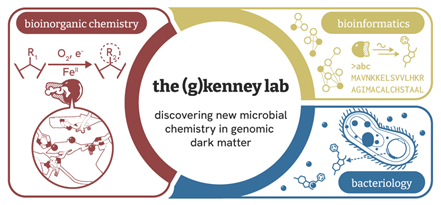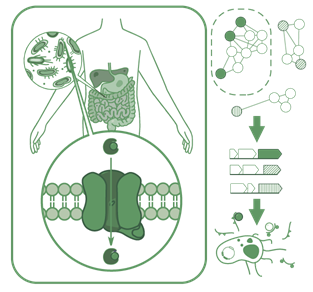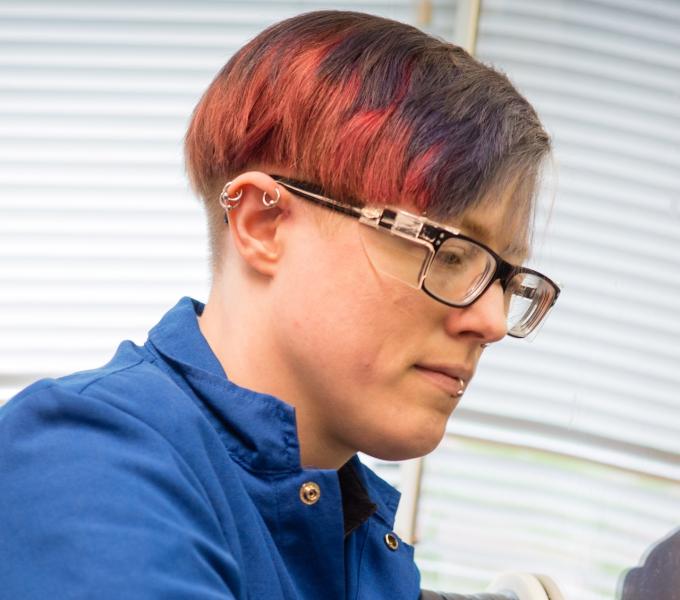The (g)kenney Lab is currently accepting new graduate students. Apply here.
Bio(inorganic) chemistry, bacteriology, and bioinformatics
Microbes are talented chemists: they employ enzymes to carry out many challenging chemical reactions, sometimes surpassing the best efforts of human chemists. But even in the best studied organisms, many proteins remain entirely unstudied. This represents a vast pool of untapped microbial chemistry. Research in the Kenney Lab will focus on identifying new types of microbial enzymes and natural products that employ previously unknown chemistry. A wide range of biochemical, biophysical, and bioinorganic techniques will be used to study these systems, complemented by computational exploration of pathways and enzyme families as well as investigation of natural product roles in microbial environments.


Investigating unstudied metalloenzyme families
Metalloenzymes are implicated in a wide range of particularly difficult or mechanistically unusual biochemical reactions. Using computational approaches, the Kenney group will identify previously unknown metalloenzyme families that post translationally modify amino acids, particularly within the context of natural product biosynthesis. We will explore the mechanisms of these enzymes in vitro as well as the roles of the resulting natural products in microbial systems.
Exploring poorly understood enzyme superfamilies

In this project, we will investigate underappreciated enzyme class that provides a route towards the production of peptidic natural products. We will establish a computational model tying protein sequence and structure to substrate reactivity. This model will be experimentally validated and expanded as we investigate new members of the enzyme superfamily and the natural products they produce. As a long-term goal, we hope to develop members of this enzyme family for biocatalytic use and for the assembly of "non-natural" products.
Discovering metallophores in complex microbial communities
 Research into microbial metal acquisition in human hosts has focused on host-pathogen competition for ferric iron. However, it is now clear that metal-binding natural products involved in metal uptake exist for many metals. We hypothesize that unique metallophores exist in the human gut microbiome, which is an anaerobic and densely populated environment distinct from those in which metallophores have been best studied. Bioinformatics, metagenomics, and metatranscriptomics will guide our identification of these metallophores, and new compounds will be structurally and (bio)chemically characterized. These results will establish the connections between microbial metal homeostasis and human health.
Research into microbial metal acquisition in human hosts has focused on host-pathogen competition for ferric iron. However, it is now clear that metal-binding natural products involved in metal uptake exist for many metals. We hypothesize that unique metallophores exist in the human gut microbiome, which is an anaerobic and densely populated environment distinct from those in which metallophores have been best studied. Bioinformatics, metagenomics, and metatranscriptomics will guide our identification of these metallophores, and new compounds will be structurally and (bio)chemically characterized. These results will establish the connections between microbial metal homeostasis and human health.
- Merck Fellow of the Damon Runyon Cancer Research Foundation (2019-2023)
- Postdoctoral Fellow, Leading Edge Symposium (2022)
- Northwestern University Widom Scholar Award (2018)
- American Heart Association Predoctoral Fellowship (2014-2016)
- Northwestern University Rappaport Award for Research Excellence (2014)
- Northwestern University Presidential Fellowship (2012-2014)
“Genome mining with hypothetical proteins.”, G.E. Kenney§. Methods in Enzymology. 717:199-240. (2025)
“Structure and function of prodrug-activating peptidases,” J.A. Velilla, G.E. Kenney, R. Gaudet Biochimie 2023, 205, 124-135
“Revving an Engine of Human Metabolism: Activity Enhancement of Triosephosphate Isomerase via Hemi-Phosphorylation,” L.F. Schachner, B.D. Soye, S. Ro, G.E. Kenney, A.N. Ives, T. Su, Y.A. Goo, M.C. Jewett, A.C. Rosenzweig, N.L. Kelleher* ACS Chem. Biol. 2022, 17, 2769-2780
“The enzymology of oxazolone and thioamide synthesis in methanobactin,” J.C.-C. Chou, V.E. Stafford, G.E. Kenney, L.M.K. Dassama Methods Enzymol. 2021, 656, 341-373
“A Peroxodiiron(III/III) Intermediate Mediating Both N-Hydroxylation Steps in Biosynthesis of the N-Nitrosourea Pharmacophore of Streptozotocin by the Multi-domain Metalloenzyme SznF,” M.J. McBride, D. Sil, T.L. Ng, A.M. Crooke, G.E. Kenney, C.R. Tysoe, B. Zhang, E.P. Balskus*, A.K. Boal*, C. Krebs*, J.M. Bollinger Jr.* J. Am. Chem. Soc. 2020, 142, 11818-11828
“MbnH is a diheme MauG-like protein associated with microbial copper homeostasis,” G.E. Kenney, L.M.K. Dassama, A.C. Manesis, M.O. Ross, S. Chen, B.M. Hoffman, and A.C. Rosenzweig J. Biol. Chem. 2019, 294, 16141-16151
“Repurposed HisC Aminotransferases Complete the Biosynthesis of Some Methanobactins,” Y.J. Park, G.E. Kenney, L.F. Schachner, N.L. Kelleher, A.C. Rosenzweig* Biochemistry 2018, 57, 3515-3523
“Chalkophores,” G.E. Kenney, A.C. Rosenzweig Annu. Rev. Biochem. 2018, 87, 645-676
“The biosynthesis of methanobactin,” G.E. Kenney, L.M.K. Dassama, M.-R. Pandelia, A.S. Gizzi, R.J. Martinie, P. Gao, C.J. DeHart, L.F. Schachner, O.S. Skinner, X. Zhu, M. Sadek, P.M. Thomas, S.C. Almo, J.M. Bollinger, C. Krebs, N.L. Kelleher, A.C. Rosenzweig Science 2018, 359, 1411-1416
“Methanobactins: from genome to function,” L.M.K. Dassama, G.E. Kenney A.C. Rosenzweig Metallomics 2017, 9, 7-20
“Copper-responsive gene expression in the methanotroph Methylosinus trichosporium OB3b,” G.E. Kenney, M. Sadek, A.C. Rosenzweig Metallomics 2016, 8, 931-940
“Genome mining for methanobactins,” G.E. Kenney, A.C. Rosenzweig BMC Biol. 2013, 11, 17
“Chemistry and Biology of the Copper Chelator Methanobactin,” G.E. Kenney, A.C. Rosenzweig* ACS Chem. Biol. 2012, 7, 260-268

